Study on Size Design of Shaft Protection Rock/Coal Pillars in Thick Soil and Thin Rock Strata
Abstract
1. Introduction
2. Project Case
3. Models and Methods
3.1. Calculation Methods
3.2. Mining Models
3.3. Model Solution
4. Solution of the Prediction Model for Shaft Deflection
5. Size Design of SPRP in Thick Soil and Thin Rock Strata
5.1. Parameters Solution
5.2. Influence of the Mining Model on Shaft Deflection
5.2.1. Analysis Process
5.2.2. Calculation Results
5.3. The SPRP Designed by the Prediction Model
5.4. The SPRP Designed by Movement Angle
5.4.1. Solution of Theoretical Soil Movement Angle
5.4.2. Analysis Results
6. Conclusions
- (1)
- With full mining, the final displacements of the shaft under the two ideal mining models are equal, while the parallel mining model is superior at the initial stage of mining. The horizontal displacement of the shaft head has a nonlinear negative correlation with the SPRP, and the pillar size in thick soil and thin rock strata calculated by the parallel mining model is more reasonable.
- (2)
- Combined with the specification design method of the SPRP, the shaft deflection can be effectively attenuated by appropriately reducing the soil movement angle. For the Guotun Coal Mine, when the soil movement angle was 57.8% of the actual value, the horizontal displacement of the main shaft head was reduced by 87%.
- (3)
- According to the current production situation of the Guotun Coal Mine, filling mining is recommended for the coal seam around the shaft; for similar newly built shafts, symmetrical or filling mining should be adopted as much as possible according to the actual situation, and lining structures that can adapt to certain bending deformations should be selected. In addition, the inside of the freezing shaft should be constructed to be large on the top and small on the bottom, which is similar to that of the drilling shaft.
Author Contributions
Funding
Acknowledgments
Conflicts of Interest
References
- Kratzsch, H. Mining subsidence engineering. Environ. Geol. Water Sci. 1986, 8, 133. [Google Scholar] [CrossRef]
- State Bureau of Coal Industry. Criterion for Coal Pillars and Coal Mining in Buildings, Water Bodies, Railways and Main Shafts; Coal Industry Press: Beijing, China, 2017; pp. 42–44. [Google Scholar]
- Zhang, R.L.; He, G.W.; Li, Z. Mining Engineering Design Manual (PartI); Coal Industry Press: Beijing, China, 2003; pp. 325–342. [Google Scholar]
- Zeenke, M.; Feng, K.P. Determination of the shape and size of shaft protection pillar in Ostrava—Karvin Coal Mine. Hebei Coal 1986, 3, 59–62. [Google Scholar]
- Haupt, W.; Schobel, F.; Sroka, A.; Feng, K.P. Determination of protection coal pillar and its size. Mine Surv. 1985, 2, 39–50. [Google Scholar]
- Kratzsch, H. Measures to Reduce Mining Damage Mining Subsidence Engineering; Springer: Berlin/Heidelberg, Germany, 1983. [Google Scholar]
- Sroka, A.; Dzegniuk, B.; Niedojadlo, Z. The Bases of Dimensioning and the Exploitation of Shaft Safety Pillars; School of Underground Minig/Szkola Eksploatacji Podziemnej: Krakow, Poland 2003. [Google Scholar]
- Wei, F.Y.; Chen, J.J.; Zou, Y.F. Influence factors and change law of protection coal pillars left. Coal Sci. Techno. 2006, 34, 85–87. [Google Scholar]
- Wei, F.Y.; Chen, J.J.; Zou, Y.F. Analytical model of protective coal pillar design for vertical section method. J. China Coal Soc. 2008, 33, 256–258. [Google Scholar]
- He, W.L.; Kang, J.R. Laws of ground movement and deformation in mountainous areas. J. China Coal Soc. 1992, 17, 1–15. [Google Scholar]
- Chen, S. A New Method for Numerical Analysis of Strata and Surface Movement; China University of Mining and Technology Press: Xuzhou, China, 1998; pp. 47–54. [Google Scholar]
- Cheng, X.L.; Liu, S.G.; Zhang, H.X. Technical Summary of Monitoring Project of Main and Auxiliary Shaft, Derrick, Head Sheave and Winch in Guotun Coal Mine; Research Report, Shandong Science and Technology University Technology Development Company: Qingdao, China, 2018. [Google Scholar]
- Litwiniszyn, J. Application of the equation of stochastic processes to mechanics of loose bodies. Arch. Mech. 1956, 8, 393–411. [Google Scholar]
- Liu, B.C.; Liao, G.H. The Law of Surface Movement in Coal Mine; China Architecture & Building Press: Beijing, China, 1965. [Google Scholar]
- Guo, W.B.; Deng, K.Z.; Zou, Y.F. Artificial neural network model for predicting parameters of probability-integral method. J. China Univ. Min. Technol. 2004, 33, 322–326. [Google Scholar]
- Zhang, H.; Wang, Y.J.; Li, Y.F. SVM model for estimating the parameters of the probability-integral method of predicting mining subsidence. Min. Sci. Technol. 2009, 19, 385–388. [Google Scholar] [CrossRef]
- Fan, H.D.; Gu, W.; Qin, Y.; Xue, J.Q.; Chen, B.Q. A model for extracting large deformation mining subsidence using D-InSAR technique and probability integral method. Trans. Nonferr. Metal. Soc. 2014, 24, 1242–1247. [Google Scholar] [CrossRef]
- Peng, S.S. Surface Subsidence Engineering; SME: New York, NY, USA, 1992. [Google Scholar]
- Knothe, S. Effect of time on formation of basin subsidence. Arch. Min. Steel Ind. 1953, 1, 1–7. [Google Scholar]
- Hu, Q.F.; Cui, X.M.; Wang, G.; Wang, M.R. Key technology of predicting dynamic surface subsidence based on Knothe time function. J. Softw. 2011, 6, 1273–1280. [Google Scholar] [CrossRef][Green Version]
- Polanin, P. Application of two parameter groups of the Knothe–Budryk theory in subsidence prediction. J. Sustain. Min. 2015, 14, 67–75. [Google Scholar] [CrossRef][Green Version]
- Zhu, X.J.; Guo, G.L.; Zha, J.F.; Chen, T.; Fang, Q.; Yang, X.Y. Surface dynamic subsidence prediction model of solid backfill mining. Environ. Earth Sci. 2016, 75, 1007. [Google Scholar] [CrossRef]
- Deng, K.Z.; Wang, J.Z.; Xing, A.S. On predicting the surface subsidence velocity in undermining process. J. China Univ. Min. Technol. 1983, 4, 68–79. [Google Scholar]
- Yu, X.Y.; Dang, T.H.; Pan, H.Y.; Wu, J.K. Theological characteristics of surface dynamic subsidence by mining. J. Xi’an Univ. Sci. Technol. 2003, 2, 131–134. [Google Scholar]
- Luo, Y. An Integrated Computer Model for Predicting Surface Subsidence due to Underground Coal Mining (CISPM). Ph.D. Thesis, Department of Mining Engineering, West Virginia University, Morgantown, WV, USA, 1989. [Google Scholar]
- Djamaluddin, I.; Mitani, Y.; Esaki, T. Evaluation of ground movement and damage to structures from Chinese coal mining using a new GIS couping model. Int. J. Rock Mech. Min. Sci. 2011, 48, 380–393. [Google Scholar] [CrossRef]
- Hu, Q.F.; Deng, X.B.; Feng, R.M.; Li, C.Y.; Wang, X.J.; Jiang, T. Model for calculating the parameter of the Knothe time function based on angle of full subsidence. Int. J. Rock Mech. Min. Sci. 2015, 19–26. [Google Scholar] [CrossRef]
- He, G.Q.; Yang, L.; Ling, G.D.; Jia, C.F.; Hong, D. Mining Subsidence Theory; China University of Mining and Technology Press: Xuzhou, China, 1991; pp. 118–157, 342–344. [Google Scholar]
- Shandong Luneng Group Heze Coal Power Development Co. LTD.; Shandong University of Science and Technology. Research Report on Surface Movement and Deformation Law of 1308 Working Face in Guotun Coal Mine; Shandong University: Qingdao, China, 2012. [Google Scholar]
- Ministry of Coal Industry. Code for Construction and Acceptance of Mine Shaft and Roadway Works (GBJ213–79); Coal Industry Press: Beijing, China, 1983. [Google Scholar]
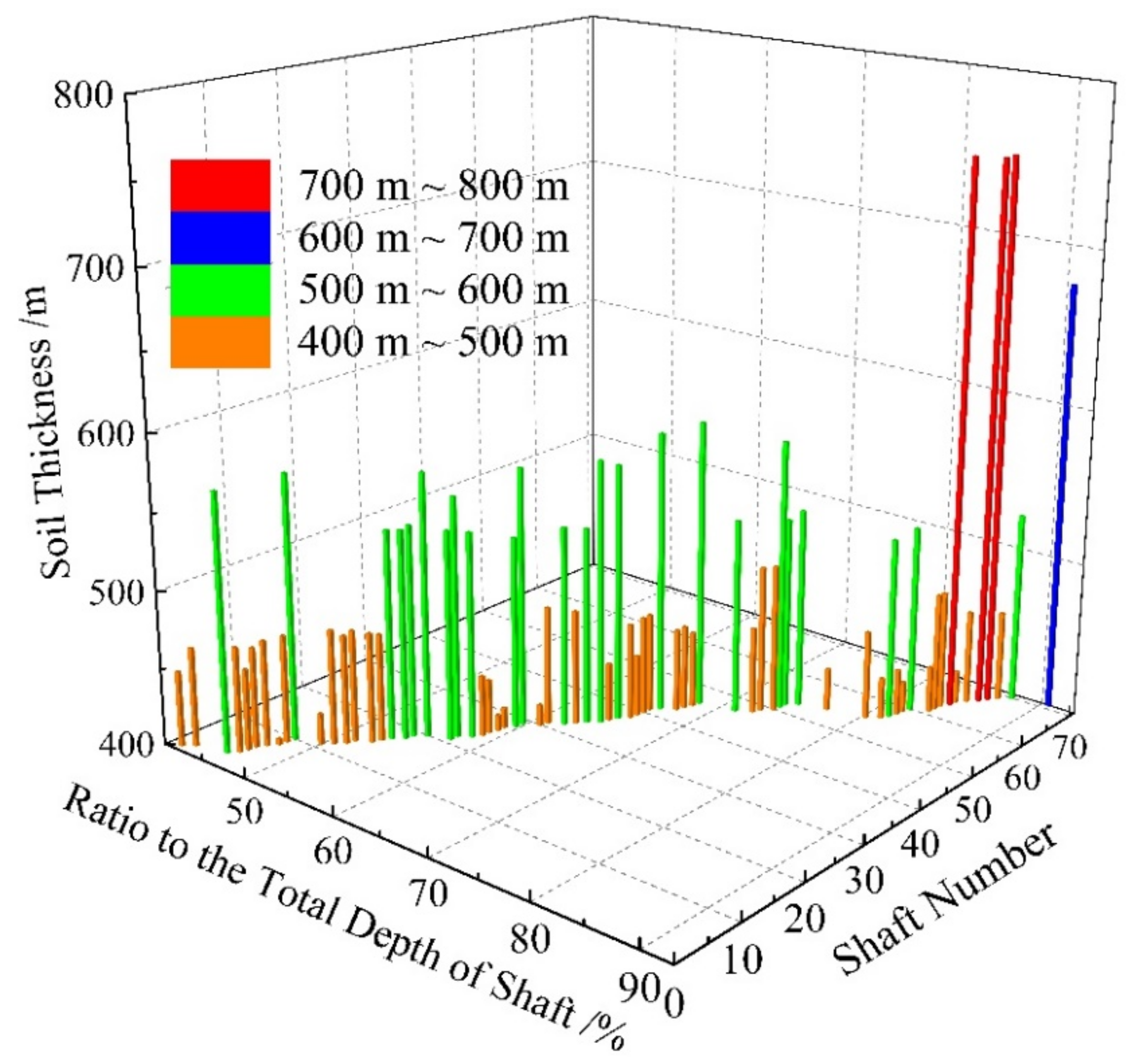
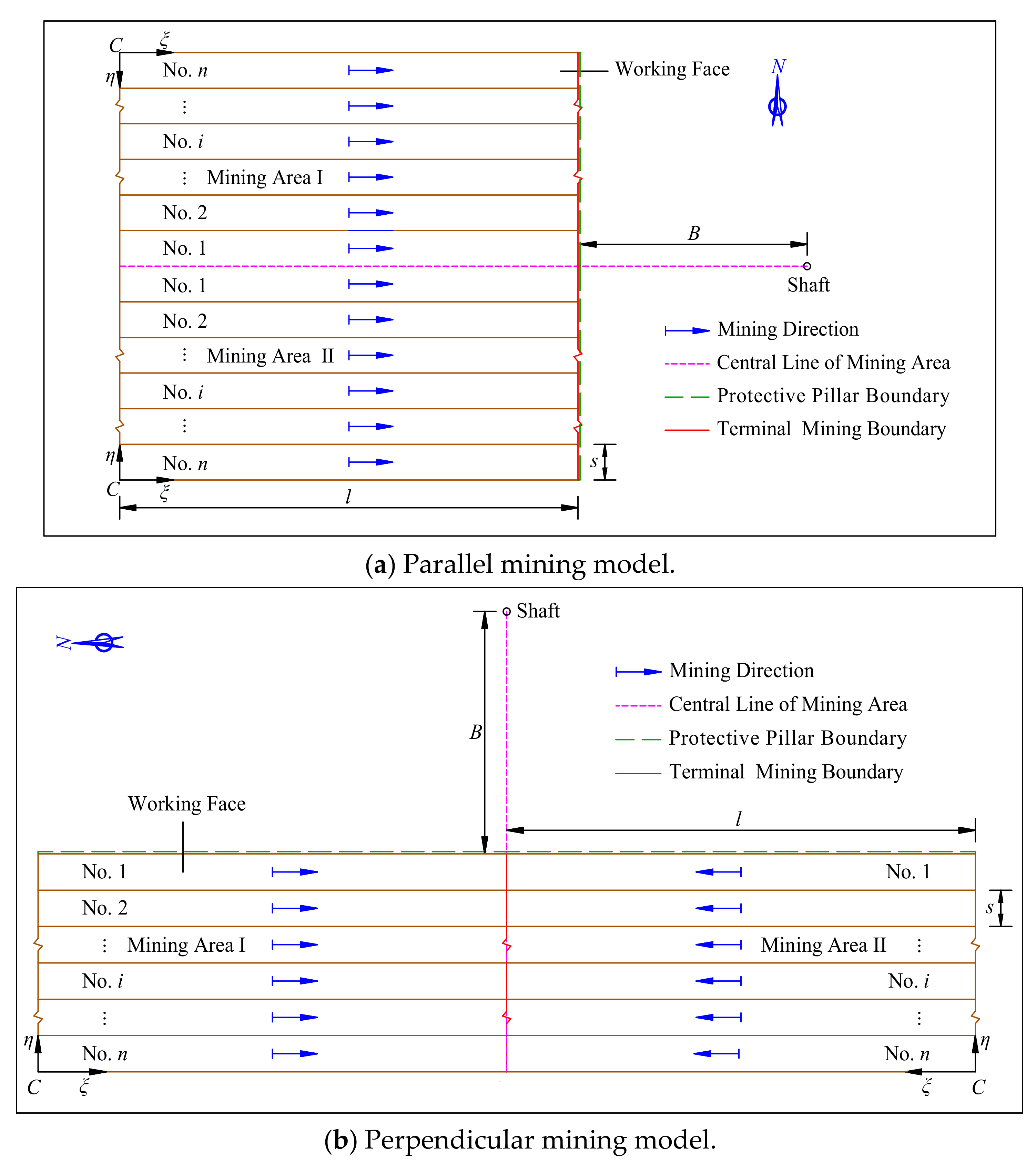
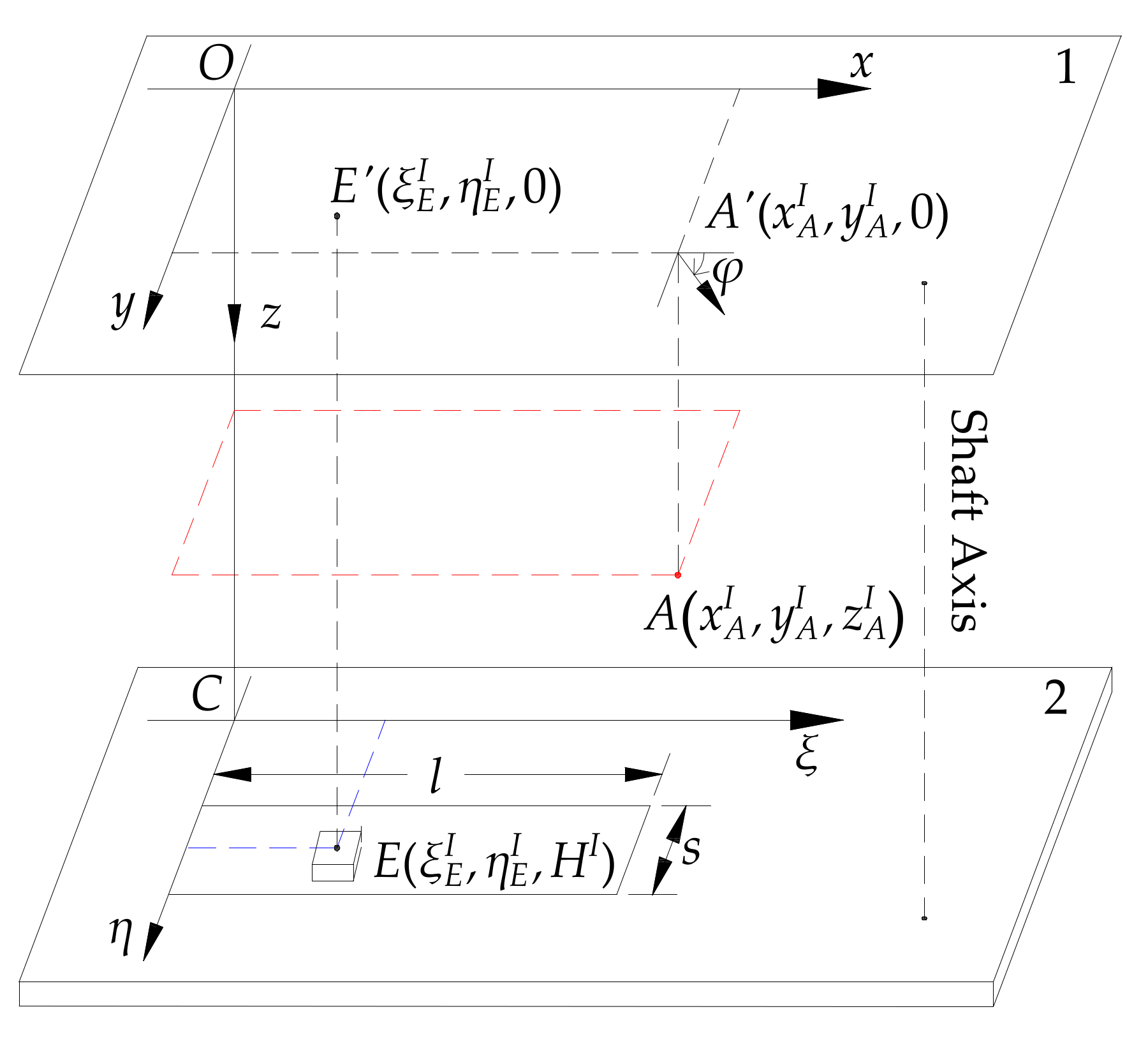
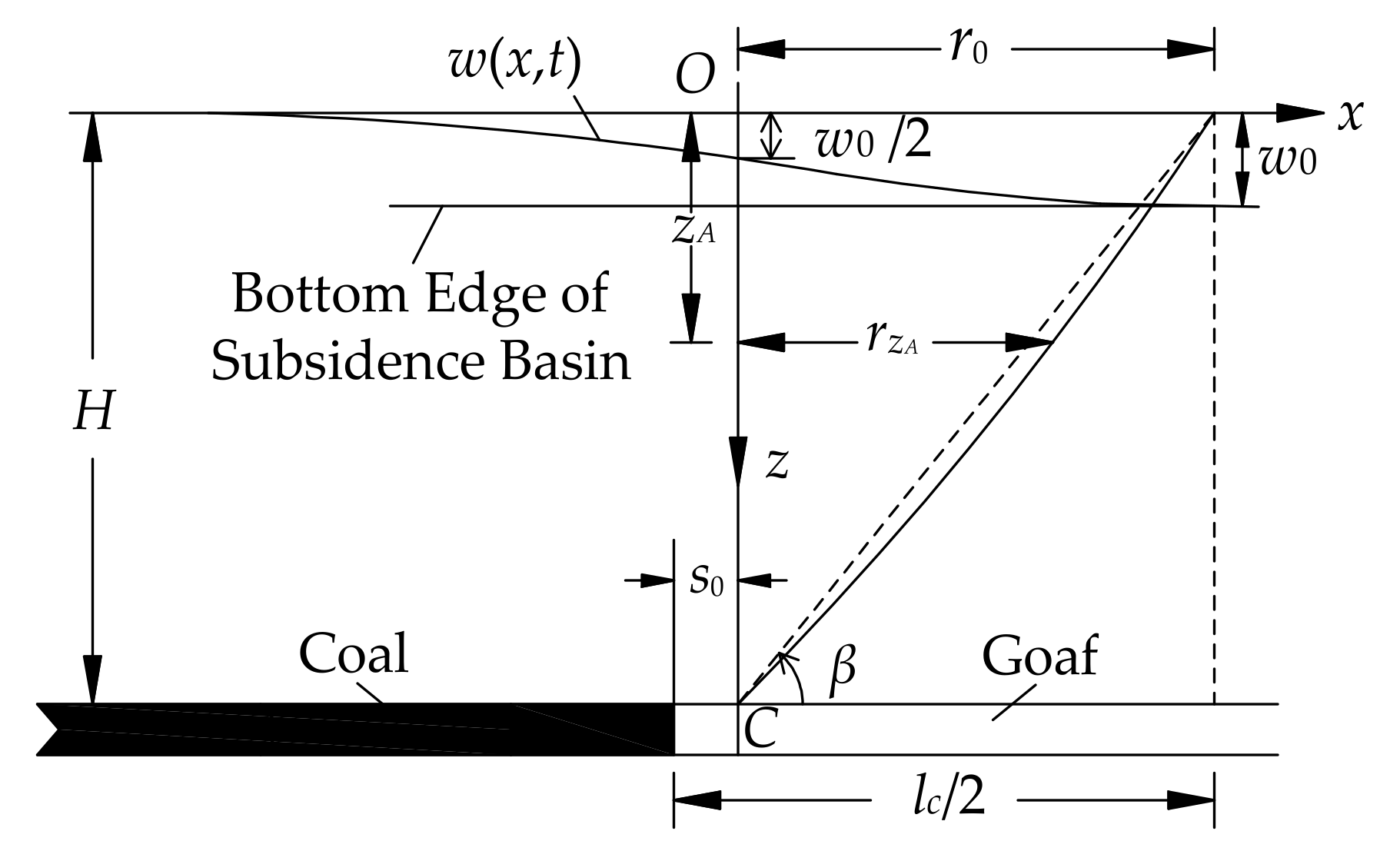
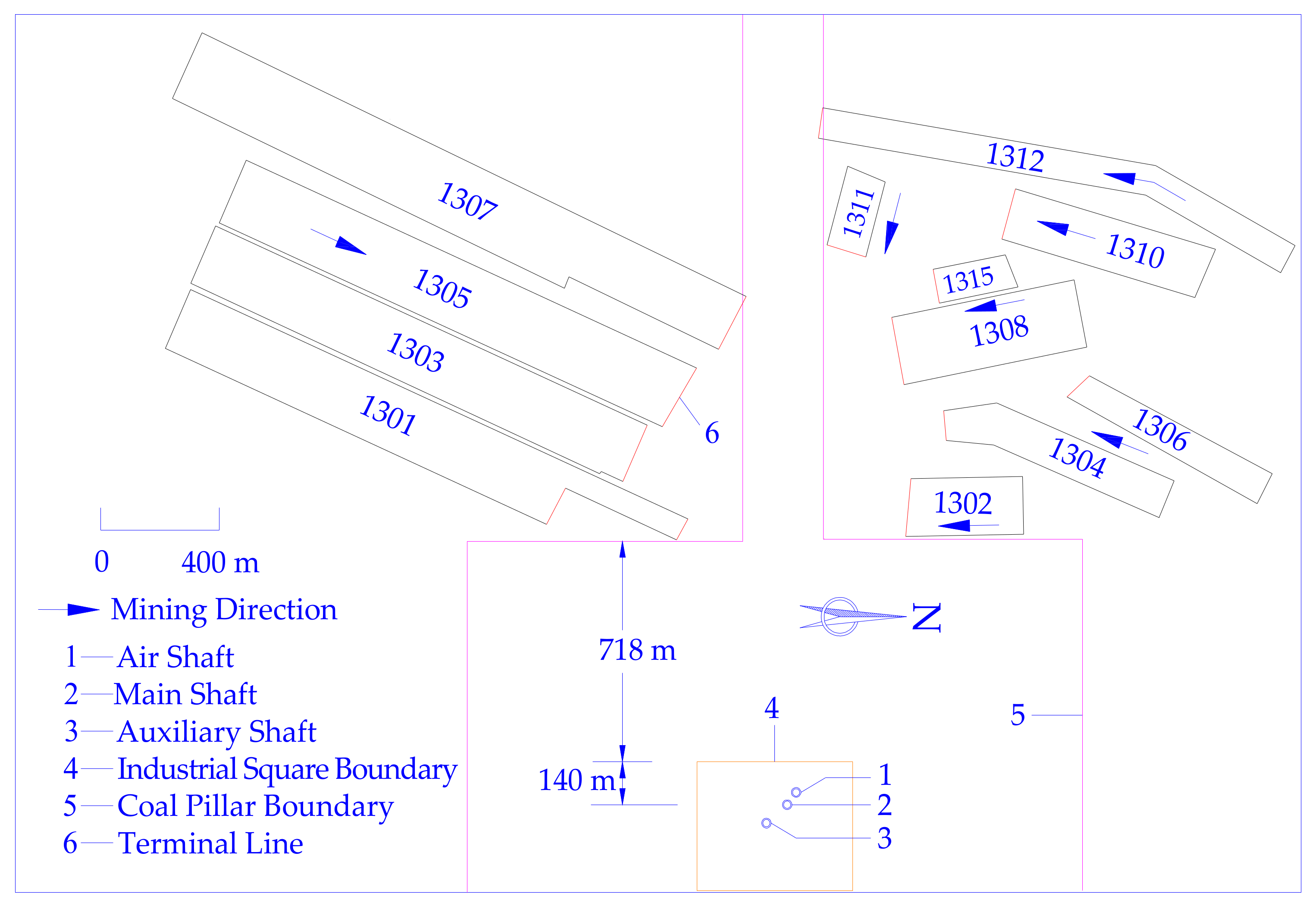
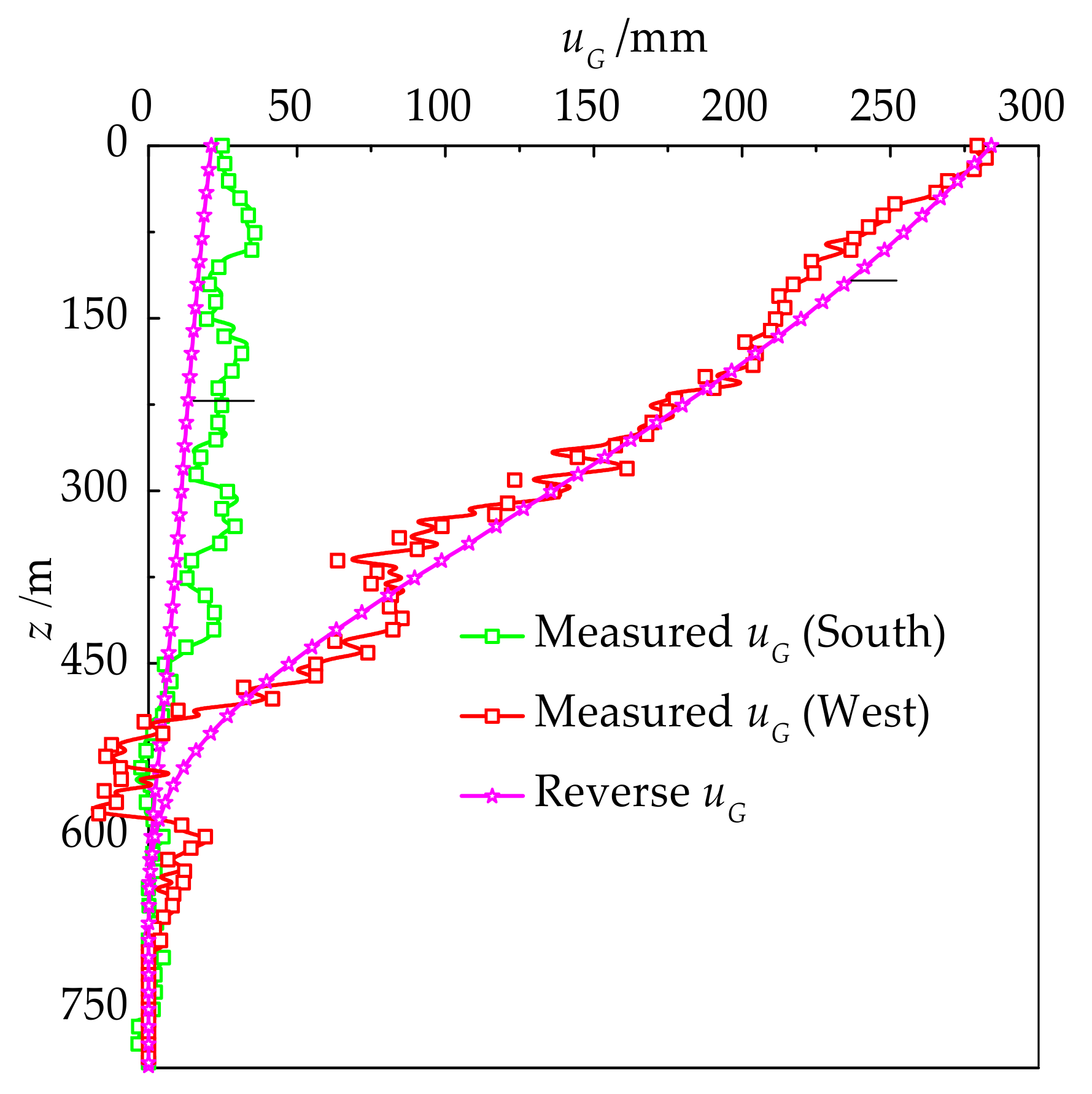
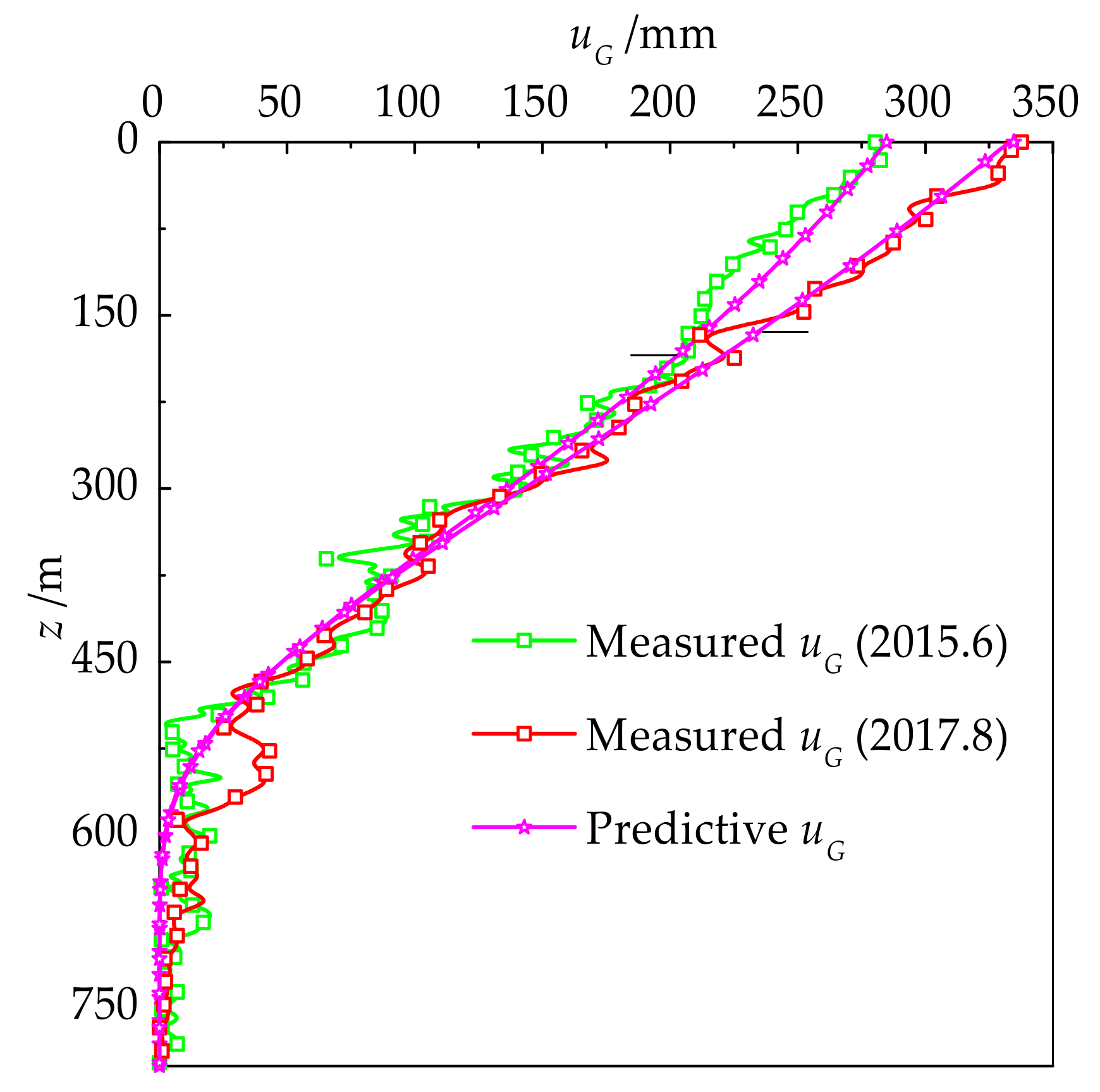
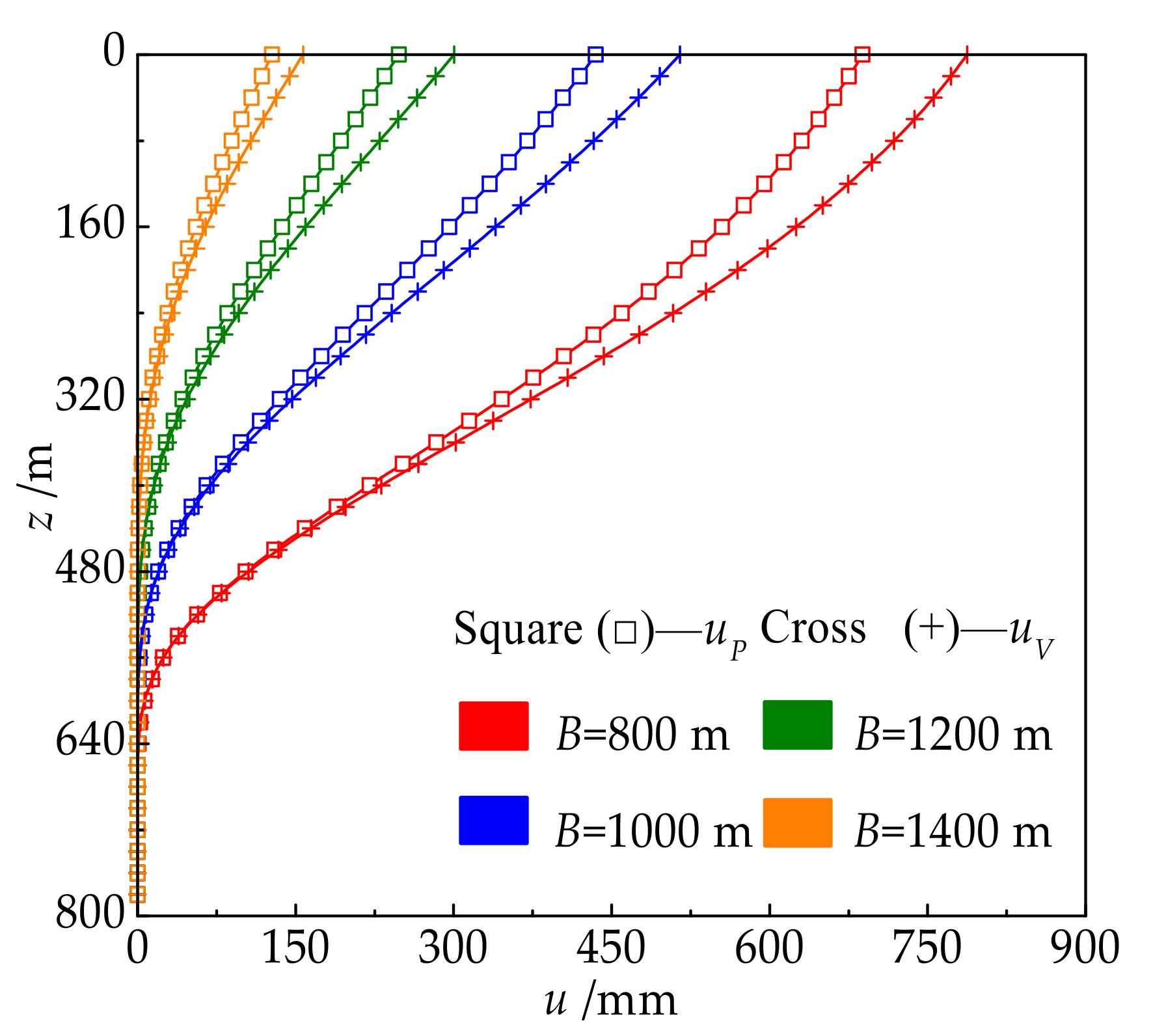
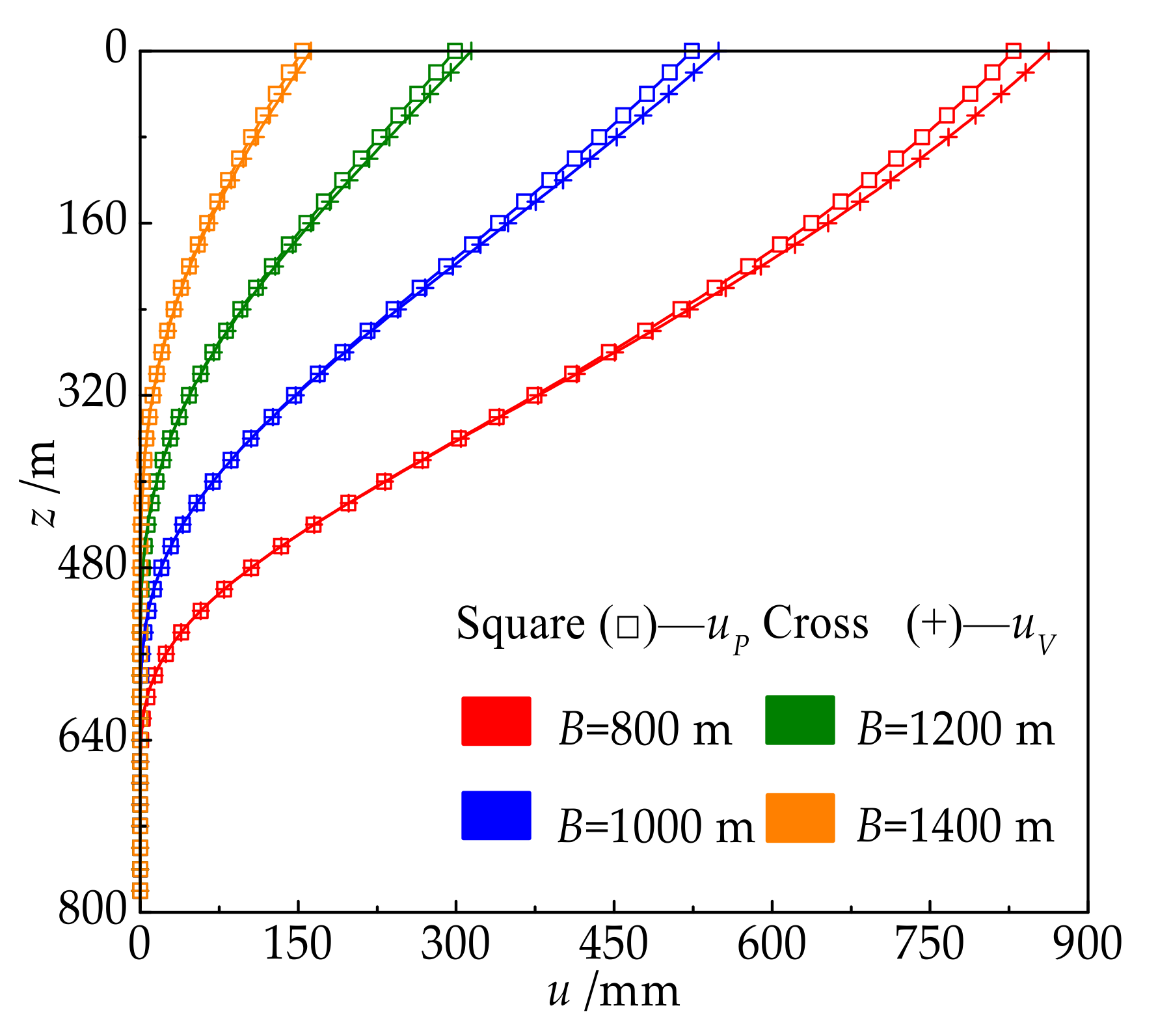




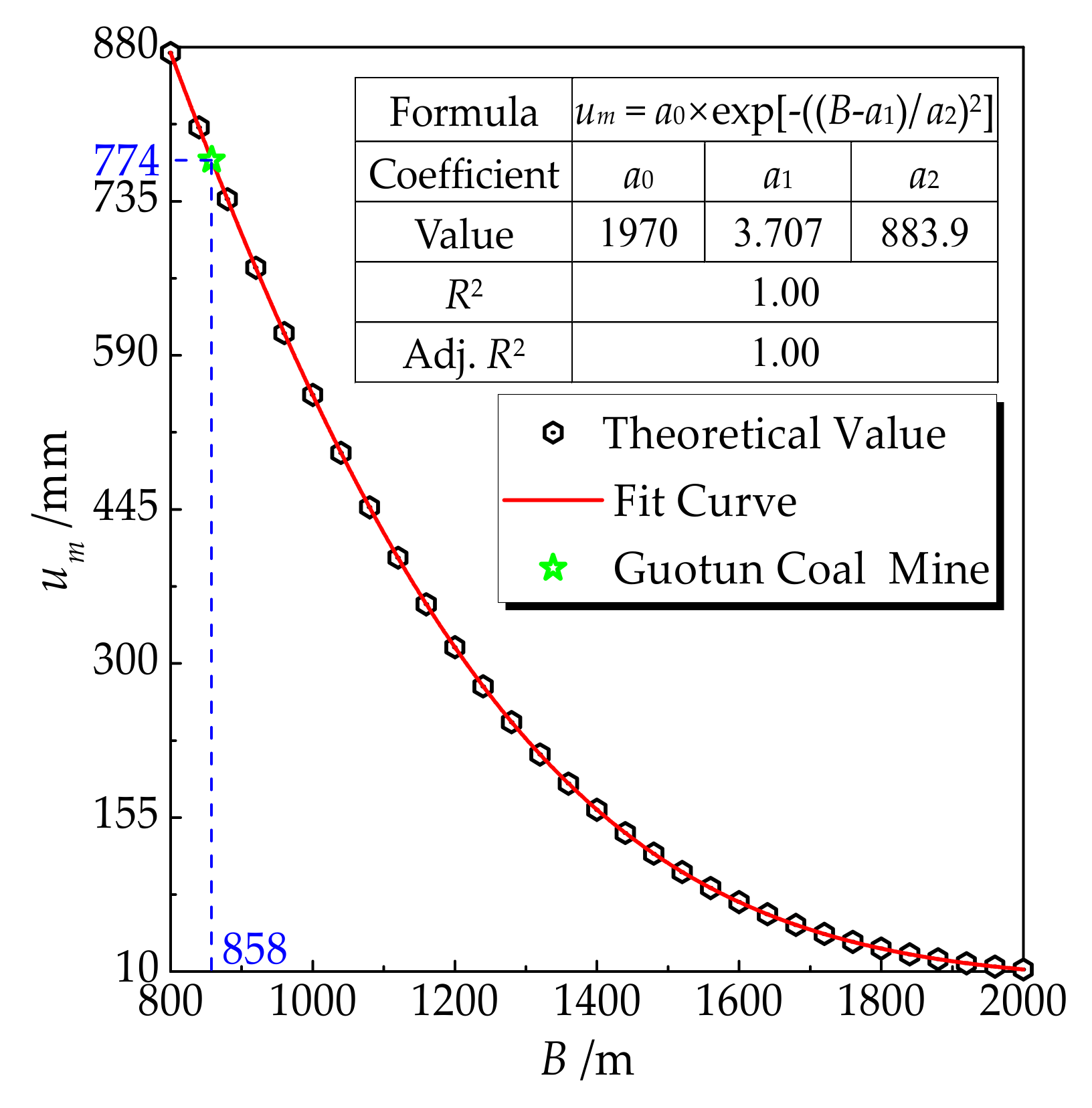
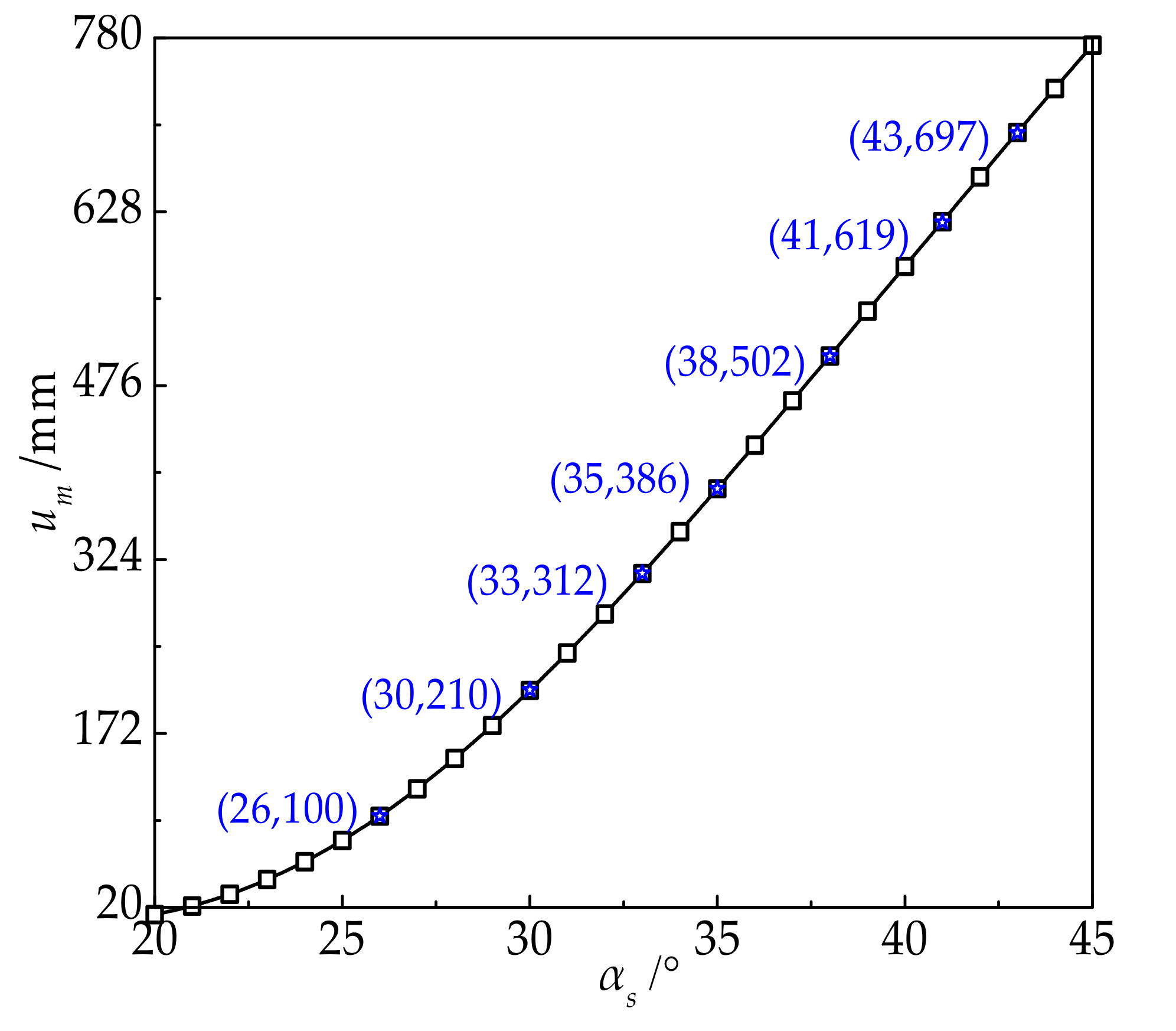
| Name of Mine | Mining Depth (m) | Movement Angles (°) | ||||
|---|---|---|---|---|---|---|
| Rock Strata | Soil Strata | |||||
| Downhill | Uphill | Strike | Dip | |||
| Jiaohe | 35–110 | 75‒0.8α | 75 | 75 | 45 | |
| Xuzhou | 90–140 | 75−0.82α; 70 −0.72α | 75; 70 | 75; 70 | 45; 36 | |
| Shuangyashan | 30–220 | 75 − 0.3α | 68 | 70 | 45 | |
| Pingyuan | 100–330 | 72 | 72 | 68 | 55 | |
| Huainan | <180 | 75 − 0.65α; 53 − 0.1α | 75 | 75 | 55; 75 − 0.65α; 53 − 0.1α | 40–45 |
| Fengfeng | <260 | 73 − 0.6α | 73 | 73 | 58 | |
| Weizhou | <310 | 73 − 0.6α | 73 | 73 | 45–55 | |
| Fuxin | <400 | 73; 83 − 0.9α | 75 | 72 | 40–50 | |
| Fushun | <540 | 59 − 0.2α | 62 | 65 | 45 | |
| Kailuan | <600 | 72 − 0.67α (≥30) | 35–72 | 70 | 35–45 | |
| Zaozhuang | <600 | 86.6 − α | 76 | 76 | 45 | |
| Changzhi | <600 | 68 − 73 | 71–74 | 71–74 | 55–66 | |
| Jining | >600 | 65 − 75 | 75 | 75 | 40–45 | |
| Juye | >600 | 75 ‒ 0.3α | 70–75 | 70–75 | 40–45 | |
| Parameters | Main Shaft | Auxiliary Shaft |
|---|---|---|
| Shaft depth (m) | 853 | 882 |
| Soil thickness (m) | 587.4 | 582.7 |
| Date | ||
| July 2015 | ||
| August 2017 | ||
| i | Face Number | si (m) | li (m) | mi (m) | Hi (m) | Coordinates | North | Start Date | End Date | |
|---|---|---|---|---|---|---|---|---|---|---|
| xi (m) | yi (m) | φi (°) | (Year. Month) | (Year. Month) | ||||||
| 1 | 1302 | 200 | 490 | 2.8 | 780 | 810 | 950 | 178 | January 2010 | July 2010 |
| 2 | 1304 | 150 | 870 | 3.2 | 770 | 785 | 1378 | 202 | August 2010 | March 2011 |
| 3 | 1301 | 227 | 1768 | 3.17 | 840 | 2525 | 692 | 335 | November 2010 | January 2013 |
| 4 | 1308 | 157 | 888 | 3.08 | 740 | 1280 | 1385 | 168 | July 2011 | March 2012 |
| 5 | 1303 | 230 | 1675 | 2.99 | 845 | 2535 | 937 | 335 | June 2012 | June 2015 |
| 1695 | August 2015 | |||||||||
| 6 | 1310 | 190 | 790 | 3.2 | 730 | 796 | 2065 | 198 | December 2012 | August 2013 |
| 7 | 1305 | 245 | 985 | 3.41 | 820 | 2531 | 1194 | 335 | September 2013 | June 2015 |
| 1250 | August 2016 | |||||||||
| 8 | 1312-1 | 130 | 640 | 3 | 730 | 655 | 2313 | 208 | March 2014 | June 2014 |
| 9 | 1312-2 | 130 | 1340 | 3 | 735 | 934 | 2137 | 188 | July 2014 | May 2015 |
| 10 | 1306 | 110 | 460 | 2.8 | 745 | 942 | 1913 | 208 | July 2015 | December 2015 |
| 11 | 1307 | 240 | 2100 | 3.3 | 770 | 2836 | 1445 | 335 | April 2016 | August 2017 |
| 12 | 1315 | 110 | 360 | 3.1 | 740 | 1090 | 1605 | 169 | July 2016 | September 2016 |
| 13 | 1311 | 136 | 266 | 3.1 | 785 | 2060 | 349 | 105 | April 2017 | July 2017 |
© 2019 by the authors. Licensee MDPI, Basel, Switzerland. This article is an open access article distributed under the terms and conditions of the Creative Commons Attribution (CC BY) license (http://creativecommons.org/licenses/by/4.0/).
Share and Cite
Han, J.; Zou, J.; Hu, C.; Yang, W. Study on Size Design of Shaft Protection Rock/Coal Pillars in Thick Soil and Thin Rock Strata. Energies 2019, 12, 2553. https://doi.org/10.3390/en12132553
Han J, Zou J, Hu C, Yang W. Study on Size Design of Shaft Protection Rock/Coal Pillars in Thick Soil and Thin Rock Strata. Energies. 2019; 12(13):2553. https://doi.org/10.3390/en12132553
Chicago/Turabian StyleHan, Jihuan, Jiuqun Zou, Chenchen Hu, and Weihao Yang. 2019. "Study on Size Design of Shaft Protection Rock/Coal Pillars in Thick Soil and Thin Rock Strata" Energies 12, no. 13: 2553. https://doi.org/10.3390/en12132553
APA StyleHan, J., Zou, J., Hu, C., & Yang, W. (2019). Study on Size Design of Shaft Protection Rock/Coal Pillars in Thick Soil and Thin Rock Strata. Energies, 12(13), 2553. https://doi.org/10.3390/en12132553





